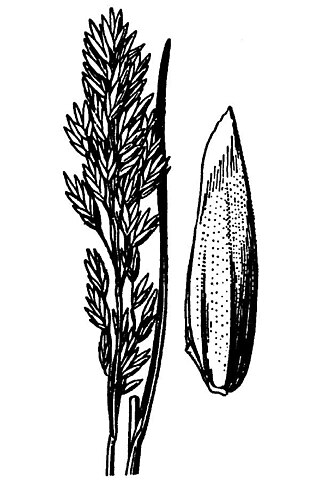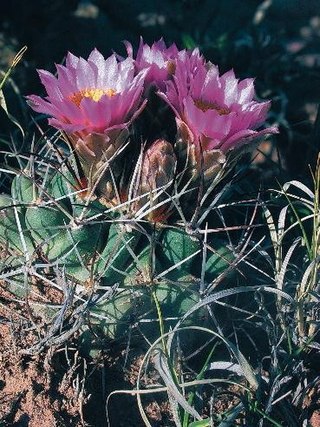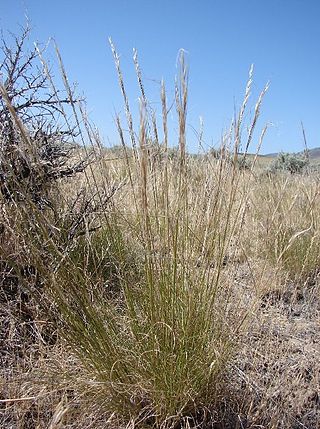
Ornamental grasses are grasses grown as ornamental plants. Ornamental grasses are popular in many colder hardiness zones for their resilience to cold temperatures and aesthetic value throughout fall and winter seasons.

Leymus is a genus of plants in the grass family Poaceae (Gramineae). It is widespread across Europe, Asia, and the Americas.

Molinia caerulea, known by the common name purple moor-grass, is a species of grass that is native to Europe, west Asia, and north Africa. It grows in locations from the lowlands up to 2,300 m (7,546 ft) in the Alps. Like most grasses, it grows best in acid soils, ideally pH values of between 3.5 and 5, however, it can continue to live under more extreme conditions, sometimes to as low as 2. It is common on moist heathland, bogs and moorland throughout Great Britain and Ireland. Introduced populations exist in northeastern and northwestern North America.

Arrhenatherum elatius is a species of flowering plant in the grass family Poaceae, commonly known as false oat-grass, and also bulbous oat grass, tall oat-grass, tall meadow oat, onion couch and tuber oat-grass. It is native throughout Europe, and also western and southwestern Asia, and northwestern Africa. This tufted grass is sometimes used as an ornamental grass and is sometimes marketed as "cat grass".

Elymus canadensis, synonyms including Elymus wiegandii, commonly known as Canada wild rye or Canadian wildrye, is a species of wild rye native to much of North America. It is most abundant in the central plains and Great Plains. It grows in a number of ecosystems, including woodlands, savannas, dunes, and prairies, sometimes in areas that have been disturbed.

Elymus glaucus is a species of grass known as blue wild rye or blue wildrye. This grass is native to North America from Alaska to New York to northern Mexico. It is a common and widespread species of wild rye.

Leymus condensatus, the giant wildrye, is a wild rye grass native to eastern Oregon, California and northern Mexico.

Leymus cinereus is a species of wild rye known by the common names basin wild rye, Great Basin wild rye, and Great Basin lyme grass. It is common in western North America.

Leymus triticoides, with the common names creeping wild rye and beardless wild rye, is a species of wild rye. It is native to western North America from British Columbia to California and Texas.

Poa cusickii is a species of grass known by the common name Cusick's bluegrass. It is native to western North America from Yukon to Colorado to eastern California, where it grows in many types of habitat, including high mountain meadows and slopes, sagebrush scrub, and forests.

Sclerocactus glaucus is a rare species of cactus known by the common name Colorado hookless cactus. It is endemic to Colorado in the United States, where it is known only from the area between Grand Junction and Montrose. It is a federally listed threatened species.

Eriocoma thurberiana is a species of grass known by the common name Thurber's needlegrass. It is native to the western United States, where it occurs from Washington to California and east to Montana and Wyoming.

Festuca thurberi is a species of grass known by the common name Thurber's fescue. It is native to a section of the western United States encompassing New Mexico, Utah, Colorado, and Wyoming. It probably also occurs in parts of Arizona.

Leymus ambiguus is a species of grass known by the common names Colorado wildrye and Rocky Mountain wildrye. It is native to the Rocky Mountains of the United States, growing mainly on rocky hillsides on the eastern slopes of the mountains in Colorado and New Mexico; it has also been reported from Utah. It is a climax species on the dry grasslands of the Colorado Front Range.
Leymus innovatus is a species of grass known as downy ryegrass, boreal wildrye, hairy wildrye, fuzzyspike wildrye, northern wildrye, and northwestern wildrye. It is native to northern North America from Alaska to eastern Canada and south to Colorado.

Psathyrostachys juncea is a species of grass known by the common name Russian wildrye. It was formerly classified as Elymus junceus. It is native to Russia and China, and has been introduced to other parts of the world, such as Canada and the United States. Psathyrostachys juncea is a great source of food for grazing animals, as it has high nutrition value in its dense basal leaves, even in the late summer and autumn seasons. This species can grow and prosper in many harsh environments, making it an ideal candidate for improvement as it can grow in areas were farming is difficult. This species is a drought-resistant forage plant and can survive during the cool seasons. It is also a cross-pollinator and is self-sterile. This means that P. juncea cannot self-fertilize; it must find another plant of the same species with which to exchange gametes. Self-sterilization increases the genetic diversity of a species.

Leymus angustus is a species of grass known by the common name Altai wildrye. It is native to Asia and Europe and it is cultivated elsewhere as a pasture grass, especially in Canada.

Poa fendleriana is a species of grass known by the common name muttongrass. It is native to western North America, where its distribution extends from western Canada to northern Mexico.

Leymus multicaulis, also known as manystem wild rye or manystem lyme grass, is a species of the genus Leymus. The species name of manystem wild rye, multicaulis, suggests the “many stems” of the species. Leymus multicaulis is considered a type of grass. Manystem wild rye has only one cotyledon in each of its seeds. The xylem and phloem within the roots are arranged in a ring pattern. The vascular bundles are scattered throughout the stem. These traits make Leymus multicaulis a monocot. Leymus multicaulis is a flowering plant, or angiosperm.

Leymus mollis is a species of grass known by the common names American dune grass, American dune wild-rye, sea lyme-grass, strand-wheat, and strand grass. Its Japanese name is hamaninniku. It is native to Asia, where it occurs in Japan, China, Korea, and Russia, and northern parts of North America, where it occurs across Canada and the northern United States, as well as Greenland. It can also be found in Iceland.



















